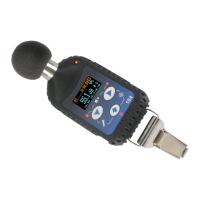SV 104 USER'S MANUAL_DRAFT_______________________________________________
_
9
1.1 Sound pressure
The human ear responds to audible sound pressure levels in the range from 20 μPa (hearing
threshold) to 20 Pa (pain threshold), resulting in the enormous scale 1:10,000,000. Since using such a large
arithmetic scale is not practical, a logarithmic scale in decibels (dB) was introduced which is also in
agreement with physiological and psychological hearing sensations. Therefore it is common that sound
pressure is measured in decibels. Below there is sample information about expected sound levels for
different sources.
Jet aircraft, 50 m away,
or gunshot at close range
Vacuum cleaner, distance 1 m
Conversational speech, 1 m
Table 1-1 Example sound source levels
1.2 Dosimetry
Noise is definitely a serious hazard in many workplaces. In case exposure to noise from machinery
processes and equipment is not correctly eliminated or controlled, it may cause permanent hearing loss
in workers. The, so called, inner ear is very fragile part of our hearing sense, which with current knowledge
in medicine, cannot be truly repaired. Therefore it is of great importance to protect our senses from
excessive noise. Exposure to high levels of noise may also create physical and psychological stress, reduce
productivity and interfere with normal communications. This may lead to accidents and injuries by making it
difficult to hear moving equipment, other workers, and warning signals. Undoubtedly hearing loss has a very
significant impact on the quality of life for many workers and their families.
Therefore measuring noise exposure in the workplace is fundamental part of all good hearing
conservation and noise reduction programs. The aim of taking a measurement with a noise dosimeter is to
evaluate the average exposure of employees to noise during a normal shift. Wherever the worker goes the
noise dosimeter goes too so that it captures all of the harmful noise during the typical day.
The dosimeter may be worn for the complete shift if the work pattern is so variable that it is difficult to
predict exactly what will occur or it may be worn for a shorter but representative period and then the full day’s
dose extrapolated from that sample.

